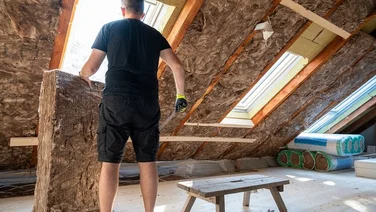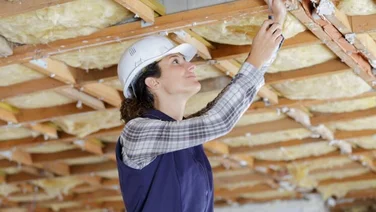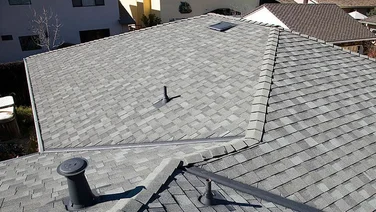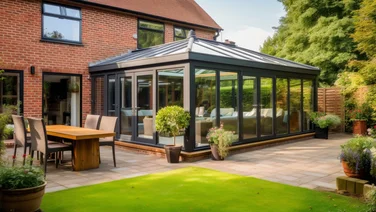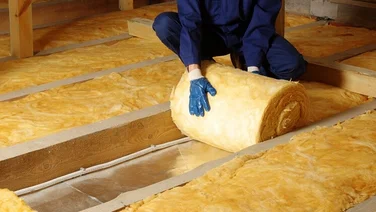- Insulation can cost between £1,400 and £12,500
- You can save hundreds on energy bills
- There are grants available for insulation
- VAT on insulation was removed in April 2022, reducing installation costs

You could also get access to an insulation grant to help with the costs of insulating your home and make accessing insulation easier.
How much insulation costs depends on your home’s circumstances, the existing insulation you have, and your budget. On average though, insulation will cost between £1,400 and £12,500.
Home insulation has been zero-rated for VAT until March 2027, which has helped reduce costs further.
This guide will give an overview of insulation costs, factors that affect the price, and what grants are currently available.
If you want to find out how much insulation might cost you, fill in our simple form. We’ll put you in touch with our trusted suppliers, who’ll provide you with bespoke quotes for you to compare.

Get free insulation quotes
Answer a few quick questions, and our trusted installers will send you bespoke insulation quotes – for free.
How much does insulation cost?
Insulation typically costs between £1,400 and £12,500, depending on the size of your home, the property type, and whether you have any insulation already. Insulating an older building with solid walls is going to cost a lot more than insulating a modern home with cavity walls, for example.
Here’s a table showing the average costs of the most common types of insulation, based on a typical three-bedroom home:
| Type of insulation | Average installation cost | Annual savings | CO2 savings per year (kilograms) |
|---|---|---|---|
| Loft insulation (270mm mineral wool) | £950 | £200 | 600 |
| Cavity wall insulation | £2,700 | £210 | 650 |
| External wall insulation (solid wall) | £11,000 | £290 | 900 |
| Internal wall insulation (solid wall) | £7,500 | £290 | 900 |
| Floor insulation (suspended floor) | £4,700 | £60 | 190 |
| Window (A-rated double glazing) | £15,000 | £120 | 380 |
| Insulating your hot water tank (80mm thick) and pipework | £25 | £40 | 180 |
(Data from the Energy Saving Trust, 2024, based on a typical semi-detached, three-bedroom property, at July 2024 fuel prices)

Cavity wall insulation
Cavity wall insulation is one of the best methods of saving money from insulating your home – you’ll typically save around £210 a year. It’s best to hire a professional for your cavity wall insulation.
They’ll inject an insulating material into the cavity between your walls, which will prevent heat leaking out.
Want to find out what materials you can use for insulating your cavity walls? You can read our guide to the best cavity wall insulation materials.
| Number of bedrooms | Average installation cost | Annual savings |
|---|---|---|
| 3 | £2,700 | £210 |
(Energy Saving Trust, 2024, based on a typical semi-detached, three-bedroom property, at July 2024 fuel prices)
Solid wall insulation
This is when you attach a layer of insulating material to either the inside or outside of your home’s walls. Solid walls are much more common in properties built before 1920, with cavity walls becoming the norm afterwards.
With solid wall insulation, you can save an average of £410 a year, but the initial cost is quite high – around £7,500 to insulate a solid wall internally, and roughly £11,000 for external wall insulation.
| Number of bedrooms | Average installation cost | Annual savings |
|---|---|---|
| 3 | £7,500 (internal), £11,000 (external) | £415 |
(Energy Saving Trust, 2024)
Floor insulation
Floor insulation is a type of insulation that typically gets installed under your floor. It stops heating leaking from your home, reducing your energy bills and helping keep you warm.
The cost of floor insulation varies depending on what type of floor you’re looking to insulate, and what insulating material you use. A suspended timber floor, for example, will cost roughly £230 per square metre, whereas solid floor insulation usually costs more.
| Number of bedrooms | Average installation cost | Annual savings |
|---|---|---|
| 3 | £4,700 | £60 |
(Energy Saving Trust, 2024)
Spray foam insulation
Spray foam insulation is one of the cheapest and most effective types of insulation you can get. It’s around 2.7 times more effective at keeping heat in than fibreglass.
It’s most commonly used in roofs (although this comes with significant downsides), but can also be used for floors and in walls.
Per square metre, you’ll pay between £20 and £50, or close to £2,500 for a three-bedroom property.
| Number of bedrooms | Average installation cost | Annual savings |
|---|---|---|
| 3 | £2,500 | £150 |
(Energy Saving Trust, 2024)

Get free insulation quotes
Answer a few quick questions, and our trusted installers will send you bespoke insulation quotes – for free.
Insulation material costs
What you’ll pay for insulation material varies a lot, and where you’re installing it. If you’re installing fibreglass in your roof for example, you’ll pay less than if you opted for spray foam insulation.
More expensive forms of insulation normally have more effective insulating properties, which will save you more money on your energy bills. So it’s a case of considering the benefits of greater savings over time versus a cheaper upfront cost.
- The cheapest insulation you can get is a jacket for your hot water tank, which costs around £20 and will pay for itself in the first year
- Spray foam insulation is typically the most expensive insulation material you can get, but very effective, although it does have drawbacks
Here are a few tips for insulating your home without breaking the bank:
- Draught-proof your home. Many areas in a home leak heat, including pipework, gaps in windows and doors, and your loft hatch. Draught excluders for doors cost no more than £10, and could save you up to £50 a year on your energy bills.
- Move your furniture. Having sofas and armchairs in front of your radiators limits the circulation of hot air, reducing their effectiveness. Shifting your furniture and other objects away from radiators will make the room feel warmer.
- Get carpet underlay. Up to 15% of a home’s heat loss goes through your floor, so getting a carpet underlay (if you have carpets) is a great way to reduce this. It costs just £3-8 per square metre to install and doing so can save you up to £75 per year.
Insulation installation costs
How the insulation is installed affects the price. If you’re installing fibreglass insulation, and in a part of your house where it’s simple to do it yourself, that will save you the cost of hiring a professional.
Installing spray foam insulation, on the other hand, comes with pitfalls that make doing it yourself a bad idea.
You risk damaging your roof, creating bad odours that linger for months, and your insulation not working properly.
Are there any government grants for insulation?
It’s always worth checking to see if your local area has any grants to help you with insulating your home.You can currently save money with three national insulation grants:
- The Energy Company Obligation (ECO4) – residents in Great Britain can get funding for energy efficiency improvements, including insulation, if you meet certain requirements. You can’t choose which home improvements you’ll get.
- Warmer Homes Scotland – this scheme offers people in Scotland grants for energy-saving home improvements, including insulation.
- Nest – homeowners in Wales have access to loft and cavity wall insulation grants, as well as other energy efficiency measures.
- Northern Ireland Sustainable Energy Programme, which is the equivalent of ECO4 for Northern Ireland. There is also the Affordable Warmth Scheme for low-income households.
Other local grants are also available. One such grant was the Home Upgrade Grant, which was primarily for homes with off-gas systems and targeted households on lower incomes or in deprived areas.
This scheme operated in York and 22 other parts of England until March 2025. The Home Upgrade Grant has since been replaced by the Warm Homes Local Grant.
How much you actually get depends on your existing energy efficiency rating and the type of fuel your house uses.

Get free insulation quotes
Answer a few quick questions, and our trusted installers will send you bespoke insulation quotes – for free.
Will it be cheaper to insulate my home in the future?
It’s difficult to predict exactly how much home insulation will cost in the future. The UK has been criticised for not doing more to support households to become more energy efficient, especially as the UK has a lot of older homes in need of better insulation, compared to the rest of Europe.
In April 2022, the VAT rating for home insulation was reduced to 0%. It is due to rise to 5% from 1 April 2027.
Is it worth spending money on home insulation?
Yes, it is definitely worth forking out on home insulation, as long as you can afford the upfront cost.
- Insulating your loft can cut heat loss by as much as 50%, which could save around £130 a year for a semi-detached three-bedroom home.
- Insulating your hot water tank can pay for itself within a year.
- Cavity wall insulation in a three-bedroom, semi-detached house will cost about £2,700, but will save £540 and let you break even in just under five years.
Those are the benefits, but before you crack on with the installation, make sure you’re aware of the common problems with cavity wall insulation.
Summary
- Insulating your home can save money and carbon emissions, but you need to know exactly what you can afford before you start.
- There are various factors that affect the cost of insulation, including material.
- There are grant schemes available to help with insulation costs – in particular ECO4, the Warmer Homes Scotland and Nest.
- The VAT removal is helpful, but the UK could still make it easier for people to insulate their homes as the upfront cost can be thousands of pounds.
- Fill in our simple form with a few details and we’ll put you in touch with our suppliers. They’ll contact you with a range of spray foam quotes for you to compare.


